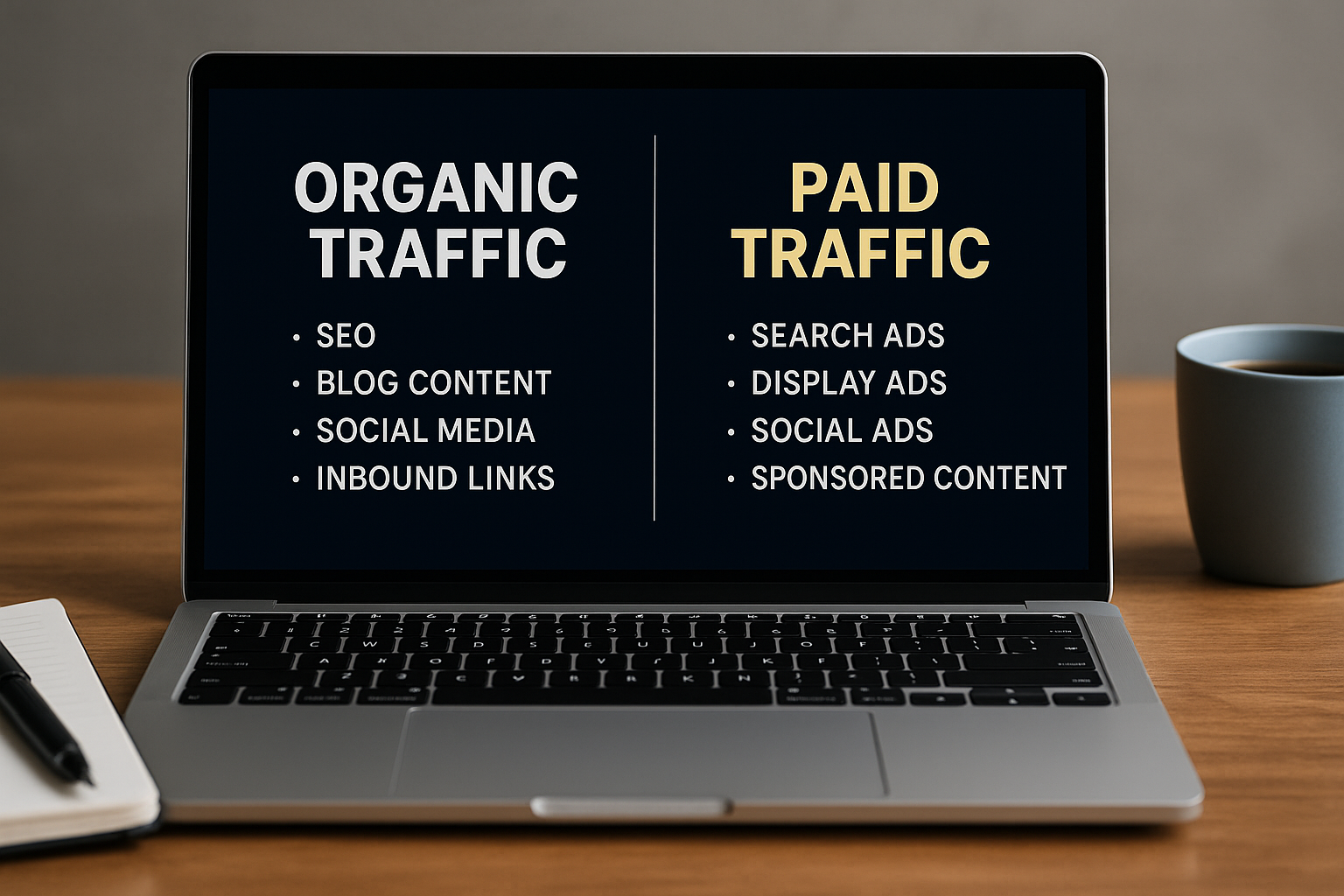If you’re building an online business, blog, or personal brand, one of your biggest questions is probably: How do I get more visitors? The answer lies in two key strategies — organic traffic and paid traffic.
While both methods aim to bring people to your website or content, they work very differently. In this article, you’ll learn the key differences between organic and paid traffic, their pros and cons, and how to choose the best option for your goals — or how to combine them for maximum results.
What Is Organic Traffic?
Organic traffic refers to the visitors who come to your website naturally, without you having to pay for ads. These visitors usually find your site through:
- Google search results (via SEO)
- YouTube videos
- Social media posts (non-sponsored)
- Email newsletters
- Backlinks from other websites
- Word-of-mouth or referrals
For example, if someone searches “best productivity tools” on Google and clicks on your blog post — that’s organic traffic.
✅ Pros of Organic Traffic
- Free (in terms of ad spend) – You don’t have to pay for clicks or impressions
- Sustainable – Great content can bring traffic for months or even years
- Builds authority – Appearing in search results improves credibility
- Long-term ROI – You invest time and effort upfront, and it can pay off long term
❌ Cons of Organic Traffic
- Takes time – SEO results can take 3 to 6 months or more to show
- Competitive – Ranking on Google is tough, especially in saturated niches
- Requires consistency – You need to produce and update content regularly
- Less control – You can’t directly control how many people see your content
What Is Paid Traffic?
Paid traffic is any visitor who comes to your website as a result of paid advertising. This includes:
- Google Ads (Search, Display, YouTube)
- Facebook and Instagram Ads
- TikTok Ads
- LinkedIn Ads
- Pinterest Ads
- Sponsored placements on blogs or websites
You pay platforms to display your content to specific audiences. For example, you can create a Facebook ad targeting people who recently visited your online store but didn’t make a purchase.
✅ Pros of Paid Traffic
- Fast results – You can start getting visitors in minutes
- Highly targeted – Show your ads only to people who match your ideal customer profile
- Scalable – Increase your ad budget to reach more people
- Measurable – Real-time analytics let you optimize performance quickly
- Perfect for launches and promotions – Ideal when you need traffic now
❌ Cons of Paid Traffic
- Costs money – You pay for every click, view, or impression
- Learning curve – Platforms like Google Ads and Meta Ads can be complex
- Not sustainable alone – Once you stop paying, the traffic stops
- Ad fatigue – People may get tired of seeing the same ad over time
Organic vs. Paid Traffic: A Side-by-Side Comparison
| Feature | Organic Traffic | Paid Traffic |
|---|---|---|
| Cost | Free (requires time/effort) | Pay per click/impression |
| Speed | Slow (long-term strategy) | Fast (instant traffic possible) |
| Control | Limited | High targeting control |
| Sustainability | Long-lasting | Ends when you stop paying |
| Trust Factor | High (people trust search results) | Varies by platform and creative |
| Ideal For | Authority, long-term growth | Launches, quick wins, testing |
Which One Should You Choose?
The best option depends on your goals, timeline, and budget. Here’s a breakdown:
🧩 Choose Organic Traffic If:
- You’re building a blog, content platform, or YouTube channel
- You have time to invest but limited money
- You want long-term, sustainable growth
- You enjoy creating helpful, SEO-optimized content
🚀 Choose Paid Traffic If:
- You’re launching a product or service and want quick visibility
- You have a marketing budget
- You need fast data to test offers or messages
- You want to scale your business rapidly
💡 Combine Both for Best Results
The most successful businesses use a mix of both. Here’s how:
- Use paid traffic to bring immediate visitors to new products or pages
- Use organic traffic to build trust and bring long-term traffic
- Retarget paid visitors using content from your blog or YouTube
- Collect emails from both channels to build your own list
This hybrid strategy gives you speed, control, and sustainability all in one.
Real-Life Examples
Example 1: E-commerce Store
- Paid: Runs Facebook Ads for a product launch
- Organic: Maintains a blog with product reviews and SEO content
Example 2: Personal Brand
- Paid: Invests in Instagram ads to grow followers
- Organic: Posts daily stories, reels, and builds YouTube content
Example 3: Affiliate Marketer
- Paid: Buys traffic to a landing page to collect emails
- Organic: Uses SEO to rank articles for affiliate products
Tools That Help You Manage Both
- Google Analytics – Track organic and paid performance
- Ubersuggest / SEMrush – SEO tools to grow organic traffic
- Google Ads / Meta Ads Manager – For paid traffic campaigns
- Ahrefs / Moz – SEO research and backlink building
- Hotjar – Understand how visitors interact with your site
Final Thoughts: Don’t Choose — Integrate
If you’re serious about growing your online presence, don’t see organic and paid traffic as competitors. Instead, think of them as teammates.
Use paid traffic to accelerate your growth, test ideas, and drive conversions. Use organic traffic to build lasting authority, community, and brand visibility.
Together, they form a powerful engine that can transform a small website into a thriving online business.

